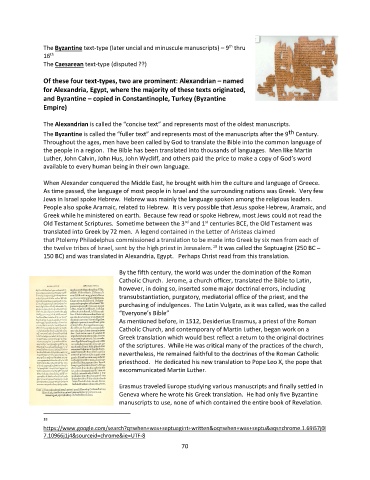Page 71 - Doctrine and History of the Preservation of the Bible Student Textbook
P. 71
th
The Byzantine text-type (later uncial and minuscule manuscripts) – 9 thru
th
16
The Caesarean text-type (disputed ??)
Of these four text-types, two are prominent: Alexandrian – named
for Alexandria, Egypt, where the majority of these texts originated,
and Byzantine – copied in Constantinople, Turkey (Byzantine
Empire)
The Alexandrian is called the “concise text” and represents most of the oldest manuscripts.
th
The Byzantine is called the “fuller text” and represents most of the manuscripts after the 9 Century.
Throughout the ages, men have been called by God to translate the Bible into the common language of
the people in a region. The Bible has been translated into thousands of languages. Men like Martin
Luther, John Calvin, John Hus, John Wycliff, and others paid the price to make a copy of God’s word
available to every human being in their own language.
When Alexander conquered the Middle East, he brought with him the culture and language of Greece.
As time passed, the language of most people in Israel and the surrounding nations was Greek. Very few
Jews in Israel spoke Hebrew. Hebrew was mainly the language spoken among the religious leaders.
People also spoke Aramaic, related to Hebrew. It is very possible that Jesus spoke Hebrew, Aramaic, and
Greek while he ministered on earth. Because few read or spoke Hebrew, most Jews could not read the
rd
Old Testament Scriptures. Sometime between the 3 and 1 centuries BCE, the Old Testament was
st
translated into Greek by 72 men. A legend contained in the Letter of Aristeas claimed
that Ptolemy Philadelphus commissioned a translation to be made into Greek by six men from each of
18
the twelve tribes of Israel, sent by the high priest in Jerusalem. It was called the Septuagint (250 BC –
150 BC) and was translated in Alexandria, Egypt. Perhaps Christ read from this translation.
By the fifth century, the world was under the domination of the Roman
Catholic Church. Jerome, a church officer, translated the Bible to Latin,
however, in doing so, inserted some major doctrinal errors, including
transubstantiation, purgatory, mediatorial office of the priest, and the
purchasing of indulgences. The Latin Vulgate, as it was called, was the called
“Everyone’s Bible”
As mentioned before, in 1512, Desiderius Erasmus, a priest of the Roman
Catholic Church, and contemporary of Martin Luther, began work on a
Greek translation which would best reflect a return to the original doctrines
of the scriptures. While He was critical many of the practices of the church,
nevertheless, He remained faithful to the doctrines of the Roman Catholic
priesthood. He dedicated his new translation to Pope Leo X, the pope that
excommunicated Martin Luther.
Erasmus traveled Europe studying various manuscripts and finally settled in
Geneva where he wrote his Greek translation. He had only five Byzantine
manuscripts to use, none of which contained the entire book of Revelation.
18
https://www.google.com/search?q=when+was+septuagint+written&oq=when+was+septu&aqs=chrome.1.69i57j0l
7.10966j1j4&sourceid=chrome&ie=UTF-8
70

